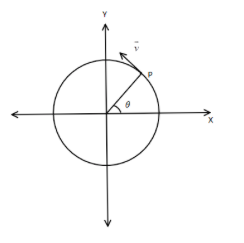
Calculate the angular and linear speed of the 2nd hand of the clock of length
Answer
540k+ views
Hint:
We all know the clock has 3 hands. The hour hand, the minute hand and the second hand. The minute hand is the 2nd hand which takes 1 hour to complete its one circle of rotation. Similarly the hour hand and second hand take 12 hours and 1 minute to complete one rotation.
Complete step by step answer:
We know that in circular motion, angular speed or velocity is a completely different physical quantity than angular speed.
Let’s look at the following diagram.

A particle in motion P, has an angular displacement of
Angular velocity is defined as rate of change of angular positions
Where
The unit of angular velocity is
The linear velocity of the particle P is displacement per unit time or
Where
Linear velocity is related to angular velocity by the following equation,
As the second hand of the clock, that is, the minute hand takes 1 hour to complete a full rotation ( a full rotation means angular displacement of
Thus the angular velocity will be,
Because 1 hour converted to seconds is
Now, the linear velocity of the 2nd hand of the clock will be,
Given that the length of the 2nd hand is
This is the value of linear velocity of the tip of the 2nd hand of the clock.
Note: Make sure you are doing calculations in the same system of units. While converting use power of 10 values for easier calculations. We can similarly calculate the angular and linear velocities of 1st and 3rd hands of a clock such that their time period for a complete rotation around the clock is 12 hours and 1 minute respectively.
We all know the clock has 3 hands. The hour hand, the minute hand and the second hand. The minute hand is the 2nd hand which takes 1 hour to complete its one circle of rotation. Similarly the hour hand and second hand take 12 hours and 1 minute to complete one rotation.
Complete step by step answer:
We know that in circular motion, angular speed or velocity is a completely different physical quantity than angular speed.
Let’s look at the following diagram.

A particle in motion P, has an angular displacement of
Angular velocity is defined as rate of change of angular positions
Where
The unit of angular velocity is
The linear velocity of the particle P is displacement per unit time or
Where
Linear velocity is related to angular velocity by the following equation,
As the second hand of the clock, that is, the minute hand takes 1 hour to complete a full rotation ( a full rotation means angular displacement of
Thus the angular velocity will be,
Because 1 hour converted to seconds is
Now, the linear velocity of the 2nd hand of the clock will be,
Given that the length of the 2nd hand is
This is the value of linear velocity of the tip of the 2nd hand of the clock.
Note: Make sure you are doing calculations in the same system of units. While converting use power of 10 values for easier calculations. We can similarly calculate the angular and linear velocities of 1st and 3rd hands of a clock such that their time period for a complete rotation around the clock is 12 hours and 1 minute respectively.
Recently Updated Pages
Master Class 12 English: Engaging Questions & Answers for Success

Master Class 12 Social Science: Engaging Questions & Answers for Success

Master Class 12 Chemistry: Engaging Questions & Answers for Success

Master Class 11 Chemistry: Engaging Questions & Answers for Success

Three beakers labelled as A B and C each containing 25 mL of water were taken A small amount of NaOH anhydrous CuSO4 and NaCl were added to the beakers A B and C respectively It was observed that there was an increase in the temperature of the solutions contained in beakers A and B whereas in case of beaker C the temperature of the solution falls Which one of the following statements isarecorrect i In beakers A and B exothermic process has occurred ii In beakers A and B endothermic process has occurred iii In beaker C exothermic process has occurred iv In beaker C endothermic process has occurred

Master Class 12 Business Studies: Engaging Questions & Answers for Success

Trending doubts
Sher Shah suri was born in A1468 B1470 C1472 D1481 class 12 social science CBSE

What are the monomers and polymers of carbohydrate class 12 chemistry CBSE

Who founded the Rashtriya Swayamsevak Sangh class 12 social science CBSE

Which are the Top 10 Largest Countries of the World?

Differentiate between homogeneous and heterogeneous class 12 chemistry CBSE

What are the major means of transport Explain each class 12 social science CBSE




